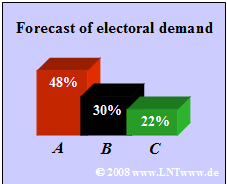Difference between revisions of "Aufgaben:Exercise 2.1: Election Demand"
| Line 6: | Line 6: | ||
In an election, the three candidates $A$, $B$ and $C$ are running for mayor. | In an election, the three candidates $A$, $B$ and $C$ are running for mayor. | ||
*The candidate who receives more than $50\%$ of the votes cast is elected. | *The candidate who receives more than $50\%$ of the votes cast is elected. | ||
| − | *If none of the three candidates succeeds in the first ballot, a | + | *If none of the three candidates succeeds in the first ballot, a runoff election shall be held between the two candidates with the most votes. |
| Line 59: | Line 59: | ||
===Musterlösung=== | ===Musterlösung=== | ||
{{ML-Kopf}} | {{ML-Kopf}} | ||
| − | '''(1)''' | + | '''(1)''' One should at least believe this demand that $\underline{\text{candidate} \ A}$ is likely to win. |
| − | '''(2)''' | + | '''(2)''' The probability that the demand $(h_{\rm A})$ differs from the final outcome $(p_{\rm A})$ by more than $2\%$ is, according to Bernoulli's law of large numbers, with $N = 2000$: |
| − | + | $${\rm Pr}(|h_{\rm A} - p_{\rm A}| \geq 0.02) \leq \frac{1}{4 \cdot 2000\cdot 0.02^2} = 0.3125.$$ | |
| − | * | + | *This probability includes the two equally likely cases that $p_{\rm A} \le 46\%$ and $p_{\rm A} \le 50\%$ is. |
| − | * | + | *Only in the last case there is no runoff: |
| − | :$${\rm Pr( | + | :$${\rm Pr(no\hspace{0.1cm}runoff)} \le 0.156 \hspace{0.15cm}\underline{=15.6 \%}.$$ |
| − | '''(3)''' | + | '''(3)''' With $\varepsilon = 4\%$ $($is given by $0.26 -0.22)$ yields the law of large numbers: |
:$${\rm Pr}\left(|h_{\rm C}-p_{\rm C}|\ge 0.04\right)\le\rm\frac{1}{4\cdot 2000\cdot 0.04^2}=0.078.$$ | :$${\rm Pr}\left(|h_{\rm C}-p_{\rm C}|\ge 0.04\right)\le\rm\frac{1}{4\cdot 2000\cdot 0.04^2}=0.078.$$ | ||
| − | + | It follows that: | |
| − | * | + | *The probability that candidate $C$ receives at least $26\%$ of the votes is not greater than $3.9\%$. |
| − | * | + | *Since $p_{\rm A} = 0.48$ was assumed fixed, in this case simultaneously $p_{\rm B} \le 0.26$. |
| − | * | + | *Since these are continuous random variables, $(p_{\rm C} \ge 0.26, \; p_{\rm B} \le 0.26)$ and $(p_{\rm C} > 0.26, \; p_{\rm B}< 0.26)$ are equal. |
| − | * | + | *Thus, the probability that $C$ reaches the runoff is also limited to $3.9\%$ : |
| − | :$${\rm Pr(}C\rm \hspace{0.1cm} | + | :$${\rm Pr(}C\rm \hspace{0.1cm}reaches\hspace{0.1cm}runoff \hspace{0.1cm}election)\le 0.039 \hspace{0.15cm}\underline{= 3.9 \%}.$$ |
{{ML-Fuß}} | {{ML-Fuß}} | ||
[[Category:Theory of Stochastic Signals: Exercises|^2.1 From Experiment to Random Variable^]] | [[Category:Theory of Stochastic Signals: Exercises|^2.1 From Experiment to Random Variable^]] | ||
Revision as of 23:13, 30 November 2021
In an election, the three candidates $A$, $B$ and $C$ are running for mayor.
- The candidate who receives more than $50\%$ of the votes cast is elected.
- If none of the three candidates succeeds in the first ballot, a runoff election shall be held between the two candidates with the most votes.
Immediately after the closing of the polling stations, the result of an election demand shall be presented:
- Candidate $A$: $48\%$, Candidate $B$: $30\%$, Candidate $C$: $22\%$.
This demand is based on a survey of only $N = 2000$ of the total $N' = 800 \hspace{0.05cm}000$ voters.
In answering the following questions, assume the following:
- The actual (percentage) votes obtained in the election by candidates $A$, $B$ and $C$ can be taken as the probabilities $p_{\rm A}$, $p_{\rm B}$ and $p_{\rm C}$ although these are also themselves determined as relative frequencies $($related to $N')$ .
- The $2000$ selected voters ideally represent the entire electorate in a statistical sense and answered truthfully when asked to vote.
- According to Bernoulli's Law of Large Numbers the results of this demand are to be understood as relative frequencies:
- $$h_{\rm A} = 0.48,\hspace{0.8cm}h_{\rm B} = 0.30,\hspace{0.9cm} h_{\rm C} = 0.22.$$
Hints:
- The exercise belongs to the chapter From Random Experiment to Random Variable.
- The topic of this chapter is illustrated with examples in the (German language) learning video Bernoullisches Gesetz der großen Zahlen $\Rightarrow$ Bernoulli's Law of Large Numbers.
Questions
Musterlösung
(2) The probability that the demand $(h_{\rm A})$ differs from the final outcome $(p_{\rm A})$ by more than $2\%$ is, according to Bernoulli's law of large numbers, with $N = 2000$:
$${\rm Pr}(|h_{\rm A} - p_{\rm A}| \geq 0.02) \leq \frac{1}{4 \cdot 2000\cdot 0.02^2} = 0.3125.$$
- This probability includes the two equally likely cases that $p_{\rm A} \le 46\%$ and $p_{\rm A} \le 50\%$ is.
- Only in the last case there is no runoff:
- $${\rm Pr(no\hspace{0.1cm}runoff)} \le 0.156 \hspace{0.15cm}\underline{=15.6 \%}.$$
(3) With $\varepsilon = 4\%$ $($is given by $0.26 -0.22)$ yields the law of large numbers:
- $${\rm Pr}\left(|h_{\rm C}-p_{\rm C}|\ge 0.04\right)\le\rm\frac{1}{4\cdot 2000\cdot 0.04^2}=0.078.$$
It follows that:
- The probability that candidate $C$ receives at least $26\%$ of the votes is not greater than $3.9\%$.
- Since $p_{\rm A} = 0.48$ was assumed fixed, in this case simultaneously $p_{\rm B} \le 0.26$.
- Since these are continuous random variables, $(p_{\rm C} \ge 0.26, \; p_{\rm B} \le 0.26)$ and $(p_{\rm C} > 0.26, \; p_{\rm B}< 0.26)$ are equal.
- Thus, the probability that $C$ reaches the runoff is also limited to $3.9\%$ :
- $${\rm Pr(}C\rm \hspace{0.1cm}reaches\hspace{0.1cm}runoff \hspace{0.1cm}election)\le 0.039 \hspace{0.15cm}\underline{= 3.9 \%}.$$
